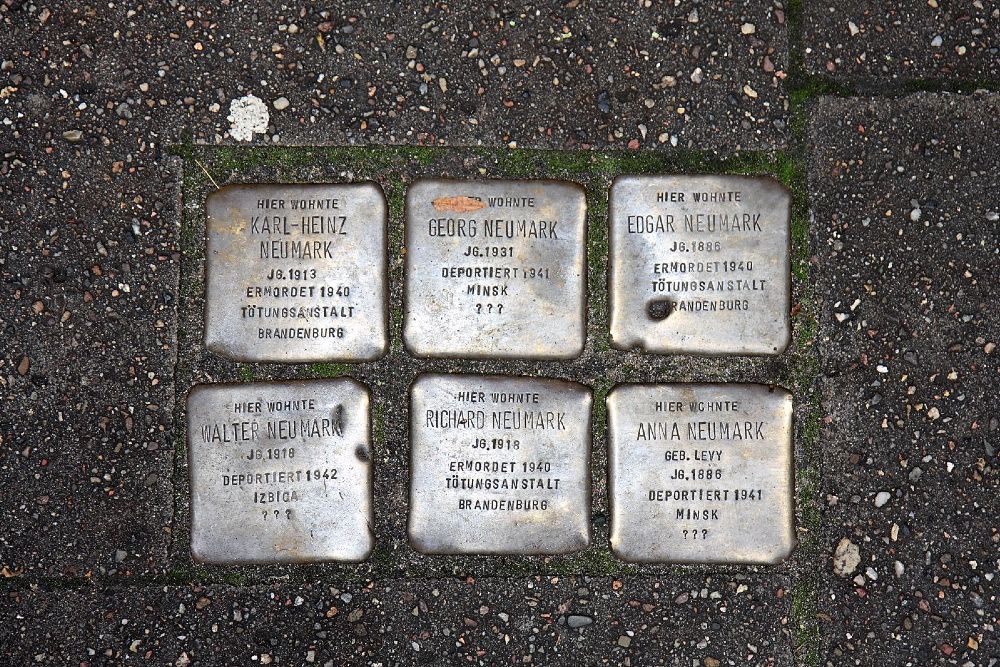Stumbling Stones Grindelallee 21-23
These small brass memorial plaques (Stolpersteine or stumbling stones) commemorate:
* Karl-Heinz Neumark, born 1913, murdered 1940, killing center, Brandenburg.
* Edgar Neumark, born 1886, murdered 1940, killing center, Brandenburg.
* Walter Neumark, born 1918, deported 1942, Izbica, ??? [fate unknown].
* Richard Neumark, born 1918, murdered 1940, killing center, Brandenburg.
* Anna Neumark, nee Levy, born 1886, deported 1941 Minsk, ??? [fate unknown].
NOTE. In the photo taken in 2007, the stolperstein for Georg Neumark (b.1931) had been mistakenly installed at Grindelallee 21. In 2012 Georg's stolperstein was moved to the correct location at Moltkestrasse 47a, (Eimsbüttel, Hoheluft West). We are looking for an up-to-date photo.
Background
Edgar Neumark and Anna Levy married before WWI. Their 3 sons were all born in Hamburg: Karl-Heinz in 1913, and the twins Richard and Walter in 1918. Edgar Neumark was a trader in second-hand materials; he was a scrap dealer. He did well until the disastrous inflationary period, which left him with acute depressive psychosis. In 1925 he was admitted to the Friedrichsberg State Hospital and spent a year there but never recovered. Anna Neumark began selling shoes in a shop, but in 1938, Nazi "Aryanization" policy meant she had to stop work. Edgar was admitted again to Friedrichsberg State Hospital at the end of 1939 and then transferred to Langenhorn Nursing and Care Home.
Karl-Heinz Neumark, the oldest son, was considered "feeble-minded" from an early age and was sent to special schools. In accordance with new laws, the Genetic Health Court approved his sterilization in 1935.
Richard and Walter Neumark started in regular primary schools but were transferred to schools for "backward" children. Both were sterilized in 1935 at age 18. They were sent to a new youth home in Hamburg on a large estate, where they worked on the farms there.
In 1937 Walter was sent to the Friedrichsberg State Hospital and then to the Alsterdorf institutions. He didn’t perform well. He was also accused of making sexual overtures to a younger boy. In 1938, Walter was moved to the Farmsen Care Home. Karl-Heinz was moved there in 1940.
Richard worked on a different farm until July 1937 when he returned to his parents at Grindelallee. More work followed. Then he was accused of improper advances towards a boy and imprisoned for several months. Three months after his release, he was in prison again for another crime until May 1940, when he was released to Langenhorn, where his father was living. Karl-Heinz was transferred there also in September 1940. Langenhorn was newly designated as a collection institution for Northern Germany people selected by doctors to be "euthanized" / murdered.
In 1940, as part of the plan to eliminate Jewish patients in sanitoriums and nursing homes, Edgar, Karl-Heinz, and Richard Neumark were taken with 133 other patients to Brandenburg State Welfare Institute (a psychiatric hospital) and murdered there with carbon monoxide gas in the killing room ("Euthanasia Center").
Walter Neumark was released from Farmsen Care Home to his parents at Grindelallee in 1939. He did various jobs, then ended up in 1941 in a Jewish nursing and care home near Koblenz. Then all patients were deported "East." Walter arrived in Izbica Transit Camp in March 1942. He was murdered either there or in one of the large extermination camps.
Anna Neumark was deported in November 1941 to Minsk. Her fate is unknown. But at age 55, even if she had been assigned to hard labor on arrival, she would have been killed in the mass execution on March 8, 1943.
"Stolpersteine" is an art project for Europe by Gunter Demnig to commemorate victims of National Socialism (Nazism). Stolpersteine (stumbling stones) are small, 10x10cm brass plaques placed in the pavement in front of the last voluntary residence of (mostly Jewish) victims who were murdered by the Nazis. Each plaque is engraved victim’s with the name, year of birth, and place (mostly a concentration camp) and date of death. By doing this, Gunter Demnig gives an individual memorial to each victim. One stone, one name, one person. He cites the Talmud: "A human being is forgotten only when his or her name is forgotten."
Do you have more information about this location? Inform us!
Source
- Text: Fedor de Vries & Anne Palmer
- Photos: Sven-Olaf Peeck
- Stolpersteine in Hamburg
- Stolpersteine.eu
- Heidi B. Neumark. Hidden Inheritance: Family Secrets, Memory, and Faith. Nashville, TN, USA: Abingdon Press, 2015. Author Heidi Neumark is a descendant of the Neumarks commemorated here.
Nearby
Museum
- Stadthaus Remembrance Site Hamburg - Hamburg
- School Museum Hamburg - Hamburg-St. Pauli
- Museum Ernst Thälmann - Hamburg-Eppendorf
Point of interest
- Remains Synagogue Poolstraße - Hamburg
- Budgepalais Hamburg - Hamburg
- Former Synagogue Portuguese Community - Hamburg-Harvestehude
Monument
- Memorial Jewish Life - Hamburg-Rotherbaum
- Memorial Weiße Rose Hamburg - Hamburg-Rotherbaum
- Memorial Neue Dammtorsynagoge - Hamburg-Rotherbaum
Cemetery
- Cemetery for Victims Siege of Hamburg - Hamburg-Altona
- Mausoleum Konrad Daniel von Blücher-Altona - Hamburg-Altona-Altstadt
- Siege Cemetery Hamburg - Hamburg-Barmbek-Süd
Remembrance Stone
- Stumbling Stones Grindelallee 25 - Hamburg-Rotherbaum
- Stumbling Stone Grindelallee 9 - Hamburg-Rotherbaum
- Stumbling Stone Grindelallee 32 - Hamburg-Rotherbaum





